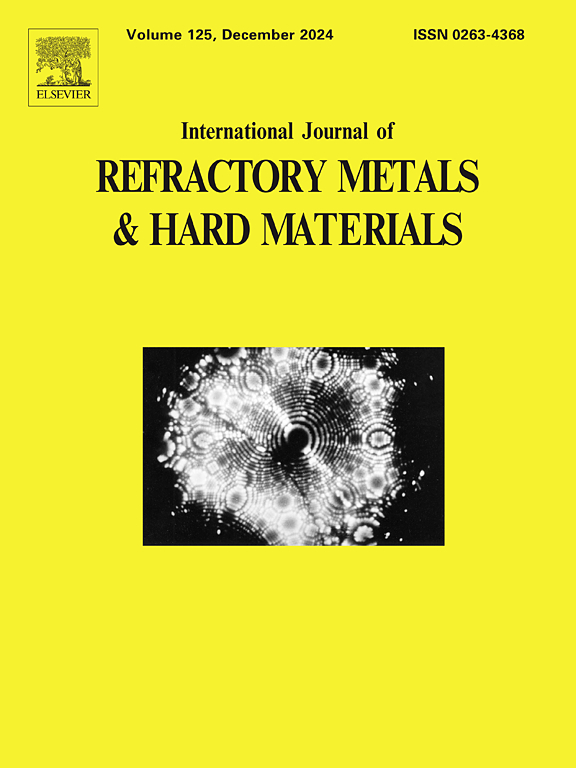钛铁矿及其蚀变产物的碳热还原
IF 4.6
2区 材料科学
Q2 MATERIALS SCIENCE, MULTIDISCIPLINARY
International Journal of Refractory Metals & Hard Materials
Pub Date : 2025-07-10
DOI:10.1016/j.ijrmhm.2025.107323
引用次数: 0
摘要
从天然含钛砂岩(俄罗斯Pizhemskoye矿床)的重精矿中获得了碳化钛和氧化碳化钛,其中钛与钛铁矿蚀变产物——伪晶圆石(电磁段P4em)和金红石(非磁性段P4nm)有关。P4em主要是钛铁矿外生-高生蚀变的产物:低晶氧氧化钛相,主要是伪晶钛(Fe₂Ti₃O₉)。低晶钛相的总含量约为60 - 65%。P4nm为高结晶金红石(约65%)。首次采用低品位煤制备的超煤作为还原剂。在1500°C的惰性气氛中,重力浓缩物的电磁和非磁性组分的碳热还原导致立方和六方TiC相的形成。由结构反射(220)计算得到的晶格参数属于有序Ti2C相。用非磁分馏法还原所得样品,对碳化氧钛的生成进行了检测。合成了两种形态类型的碳化钛颗粒。第一种形态类型的晶体的形状以接近立方的等距习性为特征。第二种形态的团聚体以碳化钛晶体的枝晶状团聚体为代表。FeSi颗粒以直径2 ~ 3 μm的球形夹杂体形式存在于碳化钛团聚体表面。对反应进行了热力学分析,提出了生成碳化钛或碳化氧的伪晶圆还原机理为:Fe2Ti3O9→TiO2/TiO + Fe→TiO + Fe→TiCxOy/TiCx□(1-x)。本文章由计算机程序翻译,如有差异,请以英文原文为准。
Carbothermic reduction of ilmenite and its alteration products using hypercoal
Titanium carbide and titanium oxycarbide have been obtained from gravity concentrate of natural titanium-bearing sandstones (Pizhemskoye deposit, Russia) in which titanium is associated with ilmenite alteration products - pseudorutile (electromagnetic fraction P4em) and rutile (non-magnetic fraction P4nm). The P4em is dominated by the products of the exogenous-hypergenic alteration of ilmenite: low-crystalline oxyhydroxide titanium phases, primarily pseudorutile (Fe₂Ti₃O₉). The total content of low crystalline titanium phases is approximately 60–65 %. The P4nm is represented by highly crystalline rutile (approximately 65 %). For the first time, hypercoal obtained from low-grade coal was used as a reducing agent. Carbothermic reduction in of electromagnetic and non-magnetic fractions of gravity concentrates an inert atmosphere at 1500 °C lead to formation of cubic and hexagonal TiC phases. The lattice parameter calculated from the structural reflection (220) belongs to the ordered Ti2C phase for samples synthesised using electromagnetic fraction. The samples obtained by non-magnetic fraction reduction the formation of titanium oxycarbide have been detected. Titanium carbide particles of two morphological types have been synthesised. The shape of crystals of the first morphological type is characterised by an isometric habitus close to cubic. Aggregates of the second morphotype are represented by dendrite-like aggregates of titanium carbide crystals. FeSi particles are found on the surface of titanium carbide aggregates in the form of spherical inclusions with a diameter of 2–3 μm. Thermodynamic analysis of the reactions was carried out and the mechanism of pseudorutile reduction with formation of titanium carbide or oxycarbide was proposed as follows: Fe2Ti3O9 → TiO2/TiO + Fe → TiO + Fe → TiCxOy/TiCx□(1–x).
求助全文
通过发布文献求助,成功后即可免费获取论文全文。
去求助
来源期刊
CiteScore
7.00
自引率
13.90%
发文量
236
审稿时长
35 days
期刊介绍:
The International Journal of Refractory Metals and Hard Materials (IJRMHM) publishes original research articles concerned with all aspects of refractory metals and hard materials. Refractory metals are defined as metals with melting points higher than 1800 °C. These are tungsten, molybdenum, chromium, tantalum, niobium, hafnium, and rhenium, as well as many compounds and alloys based thereupon. Hard materials that are included in the scope of this journal are defined as materials with hardness values higher than 1000 kg/mm2, primarily intended for applications as manufacturing tools or wear resistant components in mechanical systems. Thus they encompass carbides, nitrides and borides of metals, and related compounds. A special focus of this journal is put on the family of hardmetals, which is also known as cemented tungsten carbide, and cermets which are based on titanium carbide and carbonitrides with or without a metal binder. Ceramics and superhard materials including diamond and cubic boron nitride may also be accepted provided the subject material is presented as hard materials as defined above.

 求助内容:
求助内容: 应助结果提醒方式:
应助结果提醒方式:


